|
Brooks-Scanlon Lumber Company |
||||||||||||||||||||||||||||||||
|
|
||||||||||||||||||||||||||||||||
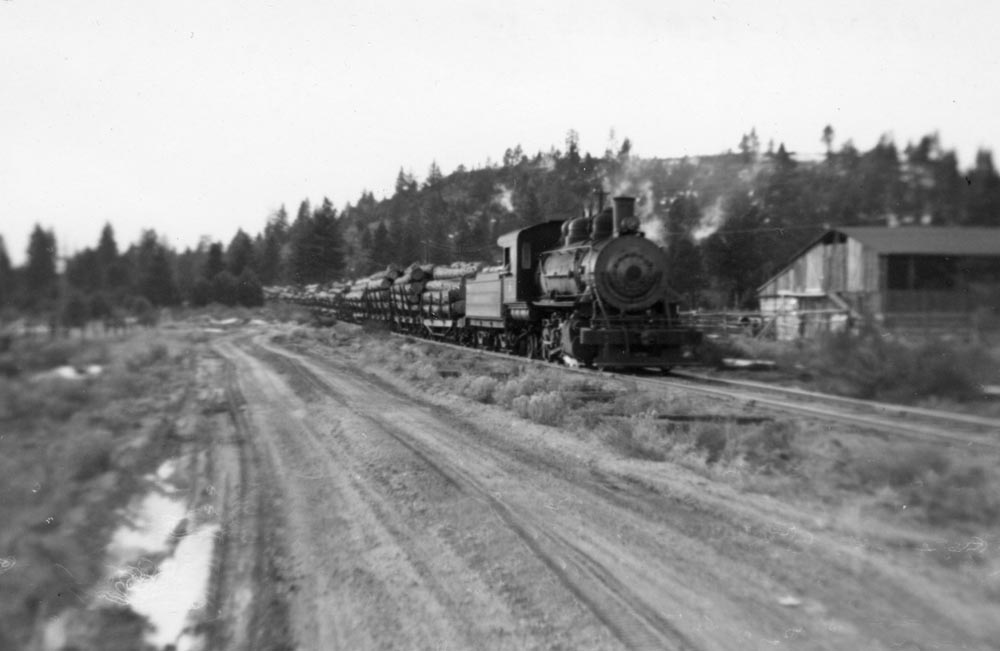 |
||||||||||||||||||||||||||||||||
|
A Brooks-Scanlon log train on its way to Bend. Jerry Lamper collection.
|
||||||||||||||||||||||||||||||||
|
|
||||||||||||||||||||||||||||||||
History In 1896 a group of lumbermen by the names of Dwight F. Brooks, Lester R. Brooks, Anson S. Brooks and M.J. Scanlon opened a sawmill in Nickerson, Minnesota. By 1901 these men had formed the Brooks-Scanlon Lumber Company and started constructing other sawmills in Minnesota. Like many other operations, Brooks-Scanlon started moving out of Minnesota when the supply of trees started to dwindle, and eventually the company had operations in Louisiana, Florida, Montana, British Columbia and Oregon. The company commenced acquiring timberlands in central Oregon starting about 1905. Timber in the area was cheap, as without a means to ship finished product to waiting markets the trees held little economic value. The company could see that central Oregon was not going to be devoid of transportation forever, and it was content to wait for it to arrive. The completion of the joint Oregon Trunk/Des Chutes Railway into Bend from the north in 1911 finally made large scale commercial timber harvests possible. By mid-August 1915 Brooks-Scanlon was ready to start operations in central Oregon, and on 1 September 1915 the company began construction on a new sawmill just south of Bend on the east bank of the Deschutes River. Work had just begun on the new mill when a fire struck, destroying the lumberyard, dry kiln and shed, for a total estimated loss of $70,000. It was the worst fire in Bend's history up to that time. Construction of the mill resumed after the fire, and the sawmill cut its first boards on 22 April 1916. 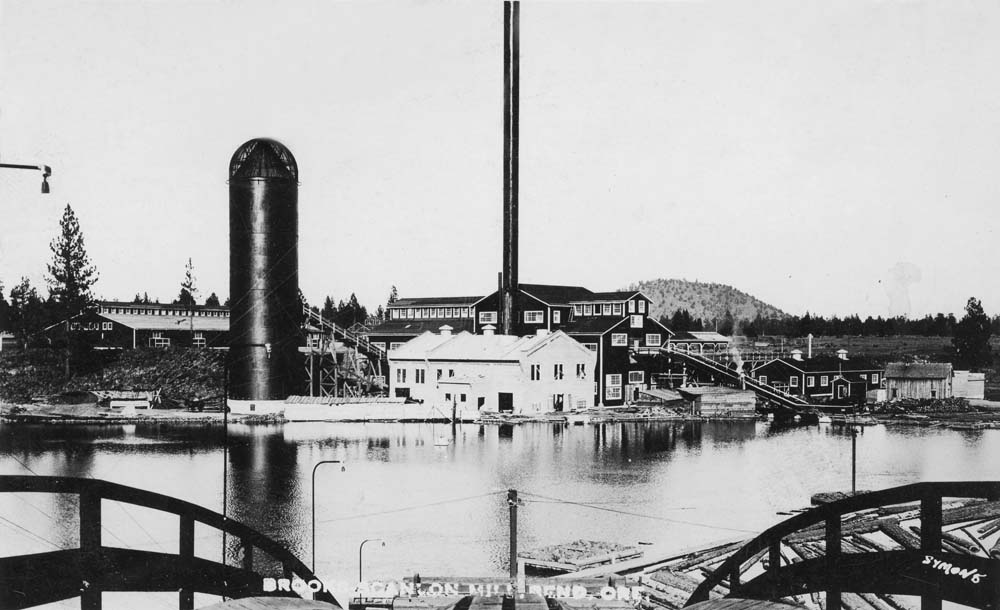 An early view of the Brooks Scanlon Mill A with Pilot Butte visible in the background. Jeff Moore collection. 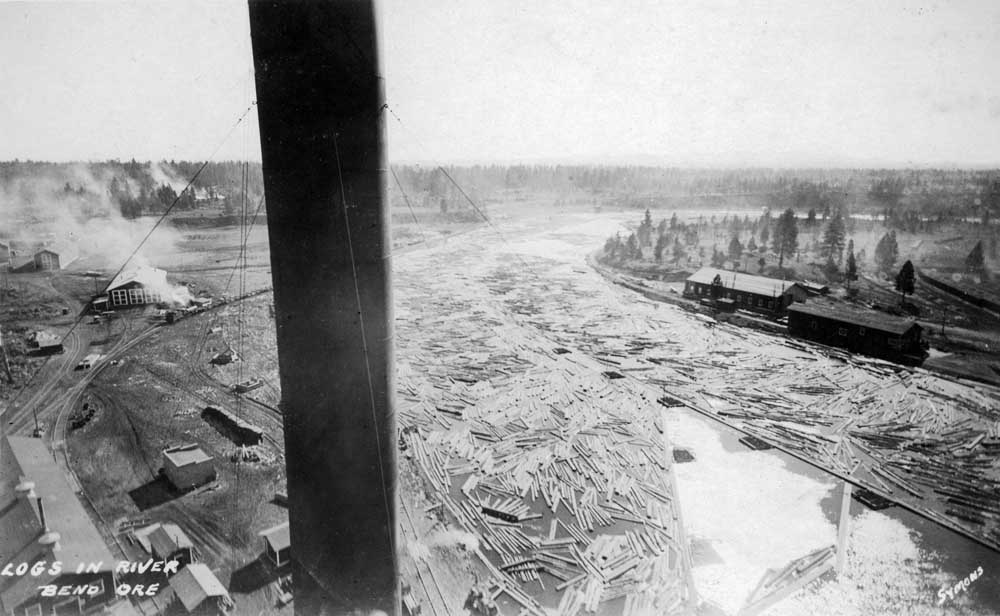 An early view looking up river from a high point in the Brooks-Scanlon mill. Plainly visible is the boom placed in the river to keep the Brooks-Scanlon (left) and Shevlin-Hixon (right) logs apart. Visible to the left side of the smokestack is the Brooks-Scanlon enginehouse, with one of the company's Baldwin Mikados in front of it. Mill B has yet to be built on the flat area behind the smoke stack, which dates this photo to sometime before 1923. Jeff Moore collection. |
||||||||||||||||||||||||||||||||
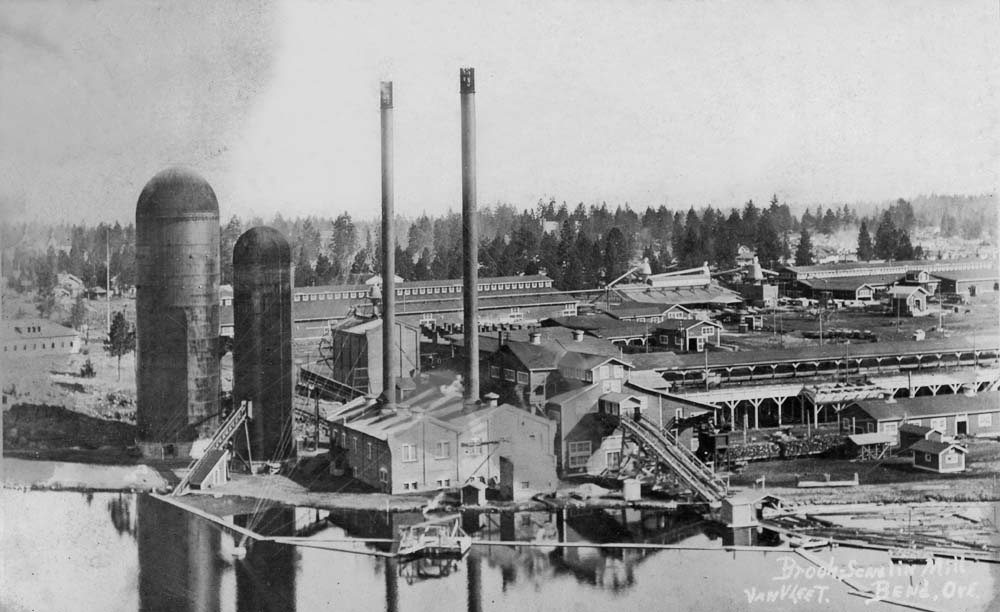 |
||||||||||||||||||||||||||||||||
|
A later view of Mill A after the powerhouse had been expanded and a second sawdust burner built. Visible in the
background are the planing mill, box factory, and other facilities. Jeff Moore collection.
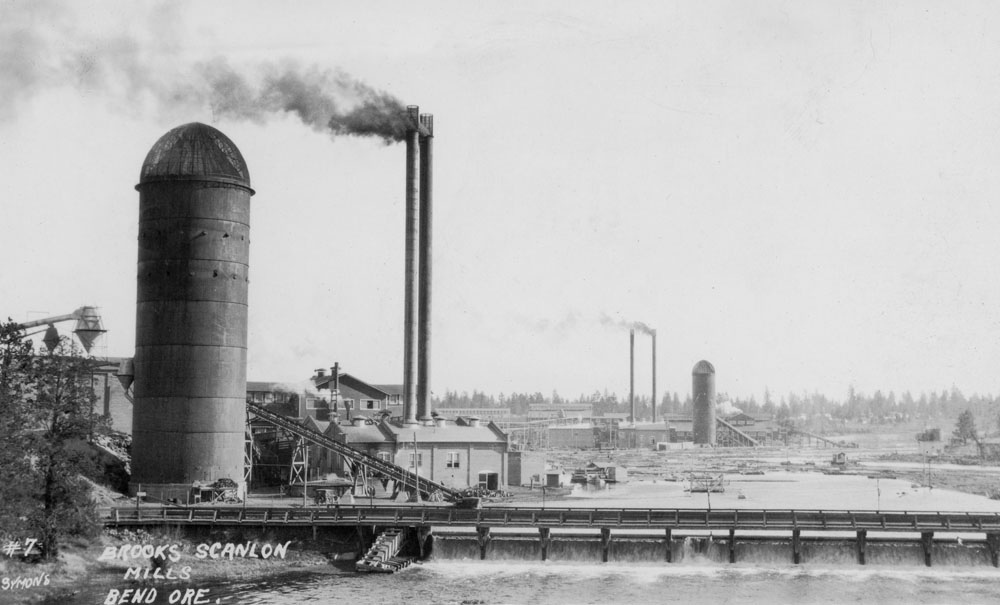 In 1923 Brooks-Scanlon built the much larger Mill B complex just west of the original mill. This view is looking upstream across the dam that created the log pond, Mill A is on the left and Mill B is visible in the distance. The Mill B powerhouse that today is the centerpiece of the Old Mill District shopping center would later get its third smokestack. Note the smaller sawdust burner at Mill A had been removed by the date of this photo. Jeff Moore collection. 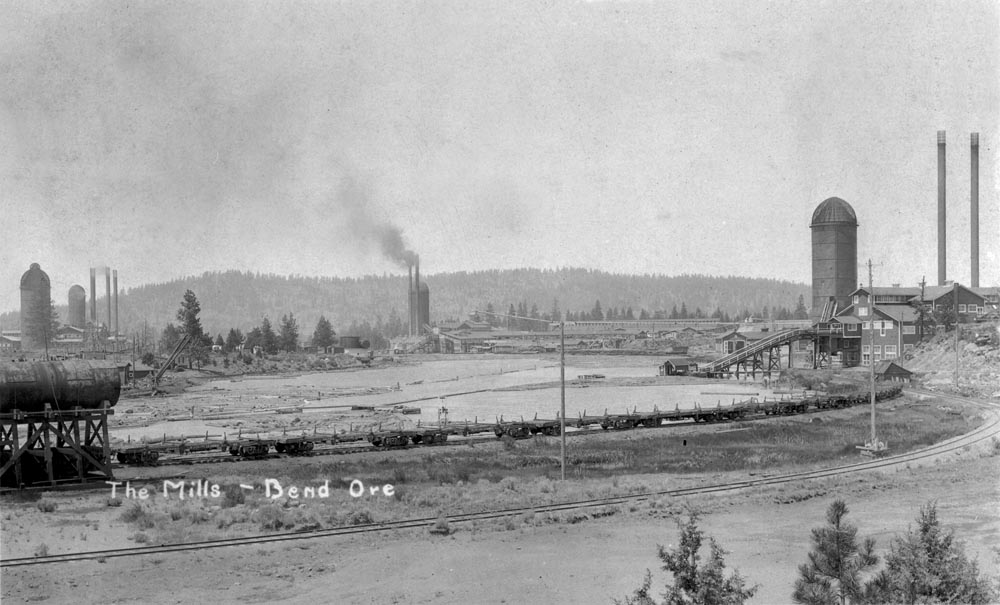 The downstream view of the Brooks-Scanlon mill complex from the other end of the complex. Mill A is in the center of the photo, with part of Mill B visible to the right and the Shevlin-Hixon mills to the left across the river. Jeff Moore collection. Most of the timber owned by the company at the time was located to the south and east of Bend, on the eastern fringes of the narrow pine belt that lay between the Cascade Mountains and the western edge of the high desert rangelands. The size of operations contemplated by the company required a railroad to bring the logs to the mill, and work on the logging railroad commenced shortly after construction of the mill began. By the end of 1915 the company had built eight miles of railroad and acquired second hand locomotive from the Spokane Portland & Seattle Railway, the parent company of the Oregon Trunk. The company generally held grades on the railroad to a maximum of 2-1/2 percent, with the steepest grade on the line found right out of the mill complex on the climb out of the Deschutes River Canyon, which was accomplished with the help of a switchback. |
||||||||||||||||||||||||||||||||
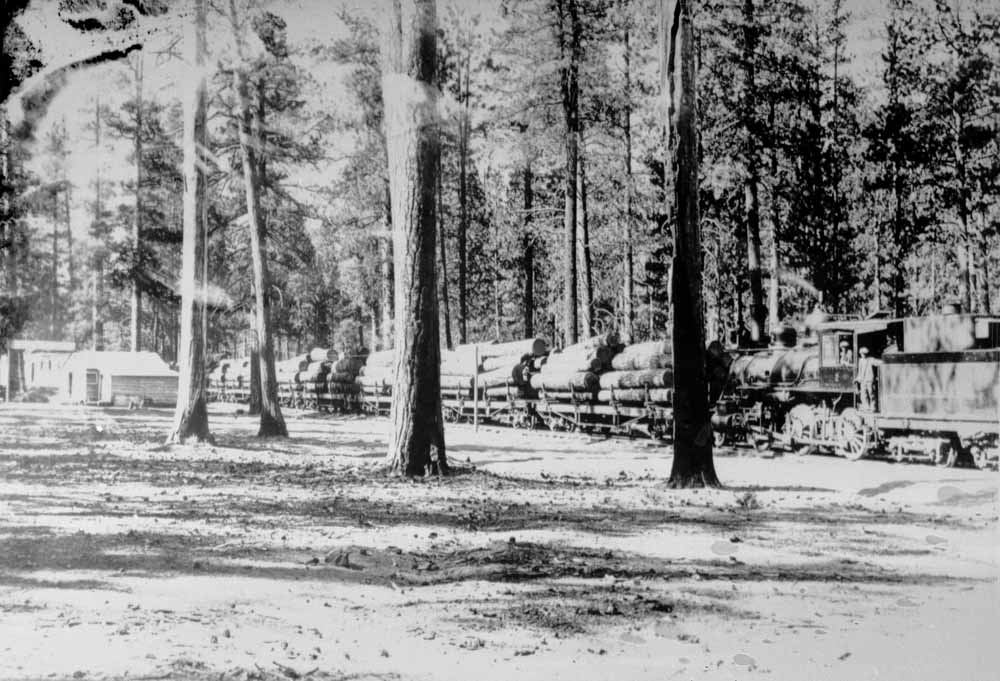 |
||||||||||||||||||||||||||||||||
|
Brooks-Scanlon #2 with an early log train in the woods south of Bend. John T. Labbe Collection of Logging and
Railroad Photographs, 1892-2010, Washington State Archives, Digital Archives, http://www.digitalarchives.wa.gov.
|
||||||||||||||||||||||||||||||||
|
Initial output of the Bend mill was around 300,000 board feet of lumber per day. By early
1918 the logging railroad had grown to 18 miles, with a logging camp located five miles
out of Bend. The company owned three locomotives by this time, and used horses and high wheels
to skid logs from the cutting site to the railroad landing. Operations continued to expand
quickly to the south and east to feed the ever growing appetite of the Bend mill. By 1922 daily
production was up to 500,000 board feet and the railroad rostered five locomotives and 160 log flats,
with a pair of Clyde skidders and some McGiffert loaders working in the woods. The company employed
over 400 men in the logging operations by this point, with the men based out of four camps. The 1926 timber industry directory reflected the company's continued expansion. The directory reported the following statistics: "Brooks-Scanlon Lumber Co., Bend; daily output, 625 M; 4 camps; 350 men; machine shop; commissary; electric light plant; air compressors; 2 Clyde skidders; 5 McGiffert loaders; 1 logging tractor; 20 sets big wheels; 125 work horses, 38 at mill; route supplies via Bend; camp telephone via same; manager, H.K. Brooks; superintendent, S.A. Blakely; purchasing agent, E.V. Ward; master mechanic, John Pengilly; 25 miles s.g. track; 56-74 lb. rail; 4 rod locomotives; 1 geared locomotive; 152 sets connected trucks; 9 flat cars; 3 box cars; 10 steel tank cars; 2 speeders; maximum curvature, 10 degrees; locomotive fuel, oil; 1 locomotive crane." These production figures made B-S the second largest single timber producer anywhere in the state of Oregon. |
||||||||||||||||||||||||||||||||
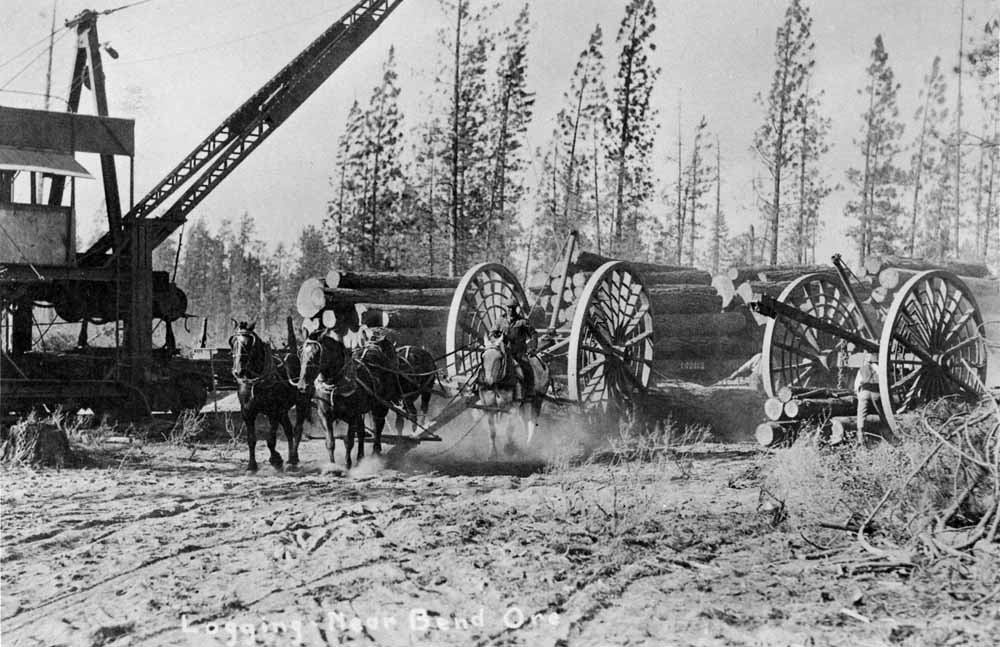 |
||||||||||||||||||||||||||||||||
|
An early Brooks-Scanlon logging scene, with horse-drawn high wheels delivering logs to one of the company's five McGiffert loaders. Jeff Moore collection.
|
||||||||||||||||||||||||||||||||
|
|
||||||||||||||||||||||||||||||||
|
The Brooks-Scanlon track layer at work. Jerry Lamper collection.
|
||||||||||||||||||||||||||||||||
|
Operations continued to expand, with nearly 70 miles of railroad in use by the late 1930s. The company
tested six Caterpillar gas tractors in 1926, and the new technology coupled with logging arches rapidly
replaced animal power in the woods. The railroad reached its southernmost point at Cabin Lake in northern
Lake Conty, and from that point spurs spread as far to the northeast as Sand Springs, not far south of
Millican, and west past South Ice Cave to Ooskan Butte. However, by 1942 the company had nearly logged out
its southern holdings, and started cutting the railroad back. The Cabin Lake line was the first to go, followed
quickly by the Sand Springs line. The end of the railroad retreated back to China Hat, and the mid-1940s the
company abandoned the entire line southeast from Bend. After the end of operations the U.S. Army used a good portion
of logged over land in the McKay Butte-Arnold Ice Cave areas to conduct war games, with the old railroad grade turned into
roads. The end of the line south of Bend did not mean the end of logging railroads, however, as in October 1943 the company started construction of a line to the northwest from Bend towards the community of Sisters. To access this new line the Oregon Trunk (Spokane Portland & Seattle) granted B-S was trackage rights over a short stretch of their tracks crossing the Deschutes River trestle. B-S built the first camp on the new line was at Bull Springs, which was active until 1946 when the timber in the area ran out. The company then built the final railroad-based log camp built by the company near the junction of the McKenzie and Santiam highways just west of the small town of Sisters. B-S continued pushing the logging railroad farther to the northwest, with branches built on both the east and south sides of Black Butte. |
||||||||||||||||||||||||||||||||
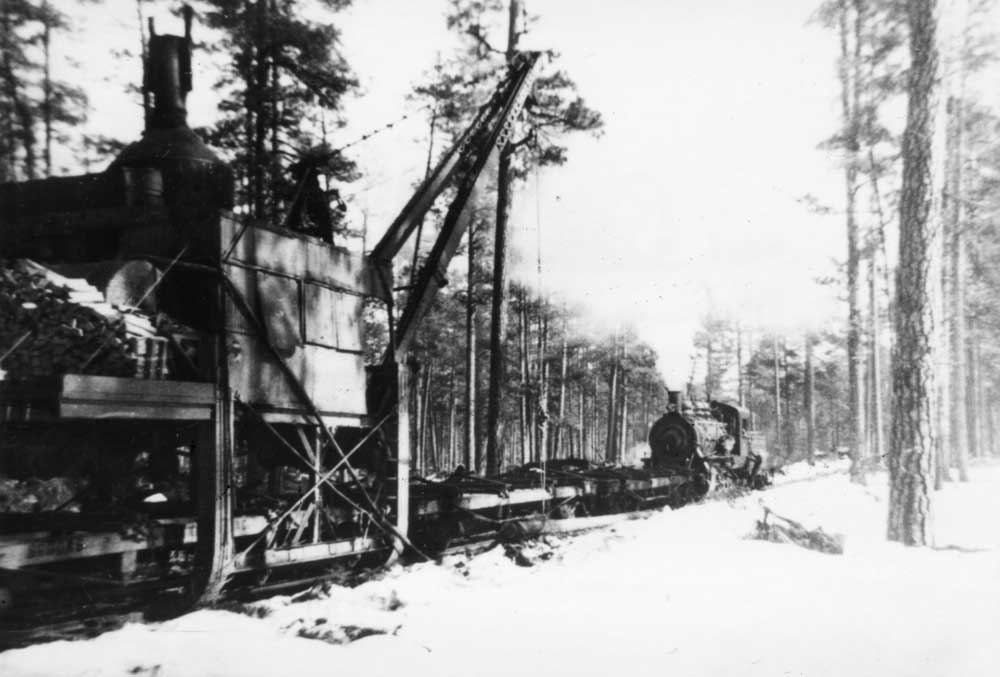 |
||||||||||||||||||||||||||||||||
|
One of Brooks-Scanlon's mikados switching a McGiffert loader in the woods. Jerry Lamper collection.
|
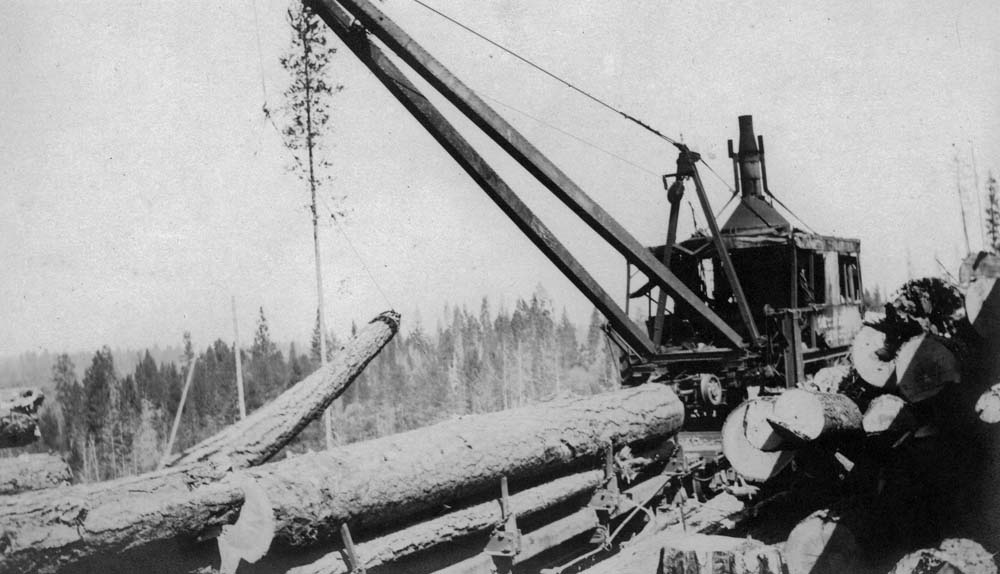
|
A later view of a Brooks-Scanlon McGiffert loader at work. Jeff Moore collection.
Since inception the Brooks-Scanlon operations in Bend had been operated under the
title of the Brooks-Scanlon Lumber Company. On 11 September 1946 the Brooks-Scanlon
Lumber Company was merged with Brooks-Scanlon Corporation of Foley, Florida, to create
Brooks-Scanlon Inc. By the mid-1930s locals were getting increasingly concerned about the ability of the forest products industry in Bend to sustain operations over the long term. The industry had started discussing conepts of sustained yield, but a study completed in 1937 concluded that the combined potential output of both the Brooks-Scanlon and Shevlin-Hixon mills were four times what the surrounding woods grew. By 1944 the two sawmills had a combined actual output of 250 million board feet per year, but by this time the remaining timber could only provide a sustained yield of 82 million board feet a year. By 1950 it was clear to both companies that the timber supply to keep both mills active simply did not exist, and in the end Brooks-Scanlon agreed to buy out the Shevlin-Hixon holdings in and around Bend. The Shevlin-Hixon mill closed for good four months after the takeover.
|
|
The Brooks-Scanlon enginehouse in Sisters. Photo by and courtesy of Jerry Lamper.
At the time of the B-S buyout Shevlin-Hixon had one active logging railroad operation
located southeast of Chemult in Klamath County. The railroad connected with
the Great Northern line at Chemult, and logs from that operation were sent north to
Bend over GN rails. The B-S takeover had little impact on the former S-H woods
operations except that the logs were delivered to the B-S mill after the S-H mill
closed and the Great Northern refused to allow B-S to continue using the trackage rights
they had previously granted S-H, and as such GN started handling the log traffic themselves.
B-S only re-lettered one S-H locomotive to reflect the change in ownership,
and the rest of the S-H locomotive fleet operated until the end of operations wearing
S-H lettering. The operation out of Chemult lasted until 1952, when the timber ran
out and the company salvaged the rails. B-S built one more log spur into "The Timbers" camp,
which lay five miles north of Gilchrist and three miles west of the GN mainline. B-S used
the ex-S-H locomotives and equipment to bring logs from The Timbers north of Bend until 1954,
when the company abandoned that line as well. B-S then brought all of the former S-H locomotives
and other equipment north to Bend, where it languished in storage for a little while before
being scrapped. In 1952 Brooks-Scanlon decided to upgrade the railroad to Sisters. The company installed heavier rails and treated ties and filled in a couple small trestles. The company also rebuilt the log car fleet with automatic air brakes and other modernizations. The railroad shops converted two of the old McGiffert loaders to diesel power by removing the original boiler and hoisting mechanisms from the frame and then installing the cabs and booms from a diesel shovel and a diesel powered locomotive crane in their places. The pair functioned well in the loading of log cars up until the end of operations. The biggest change, however, was in the locomotive department. After testing various diesel demonstrator models, the company purchased two new diesel switchers from the American Locomotive Company in 1952, which allowed for the retirement of most of the steam power save for the #5, which continued in operation as a backup to the new diesels and to run the track layer since it's operation required a steady supply of steam.
|
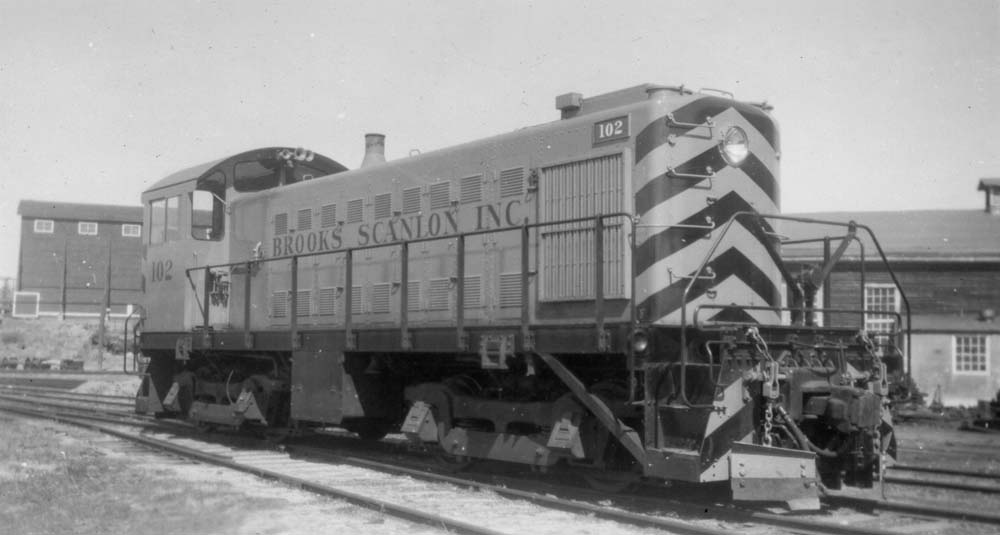
|
Brooks-Scanlon #102 in the Bend mill. Jerry Lamper collection.
The railroad continued to run until 1956, when a new logging superintendent decided to try a
season without the railroad. The railroad sat silent until September of that year, when the company
re-activated it to start bringing logs down from Bear Springs on the Sisters Line. The
railroad saw extensive use during September and October, as the company built
up enough of a cold deck to sustain operations of the mill while it fully changed over from rail to
truck logging. The last log train rolled into Bend in early November. The track crew started the job of scrapping the railroad on 14 November 1956. Work progressed steadily through the winter, and the job was completed on 9 February 1957. The company then converted the roadbed into a private truck road, and the era of logging railroads out of Bend came to a close. B-S sold all equipment save for a tracklayer, a locomotive crane, a caboose, a snowplow, a few ballast hoppers and some flatcars, with the diesels going to the Edward Hines Lumber Company for use on their operation out of Seneca, OR, and the log flats going to the Canadian Forest Products railroad on Vancouver Island, British Columbia, and to the Georgia Pacific operations in Samoa, California and Coos Bay, Oregon. The balance of the railroad equipment remained in storage at the mill until the company needed the land upon which it sat for a major mill expansion, at which time it was scrapped and the last of the rails in the mill complex were removed. The Brooks-Scanlon mill remained active until 1980, when it merged into the Diamond International Corporation. The sawmill remained open and active until 1994, when it finally closed. Most of the sawmill buildings have been torn down, with the entire mill site now turned into an upscale shopping facility know as "The Old Mill District". The old railroad grade towards Sisters is still very much in evidence. One of the diesels still exists in Washington, and one of the steam locomotives also exists in a park in Corvallis, Oregon. Meanwhile, the Brooks-Scanlon Lumber Company morphed into Brooks Resources, which is still a pillar of the Bend community and in many ways led the transition from a timber town to the tourist destination the city has become.
|
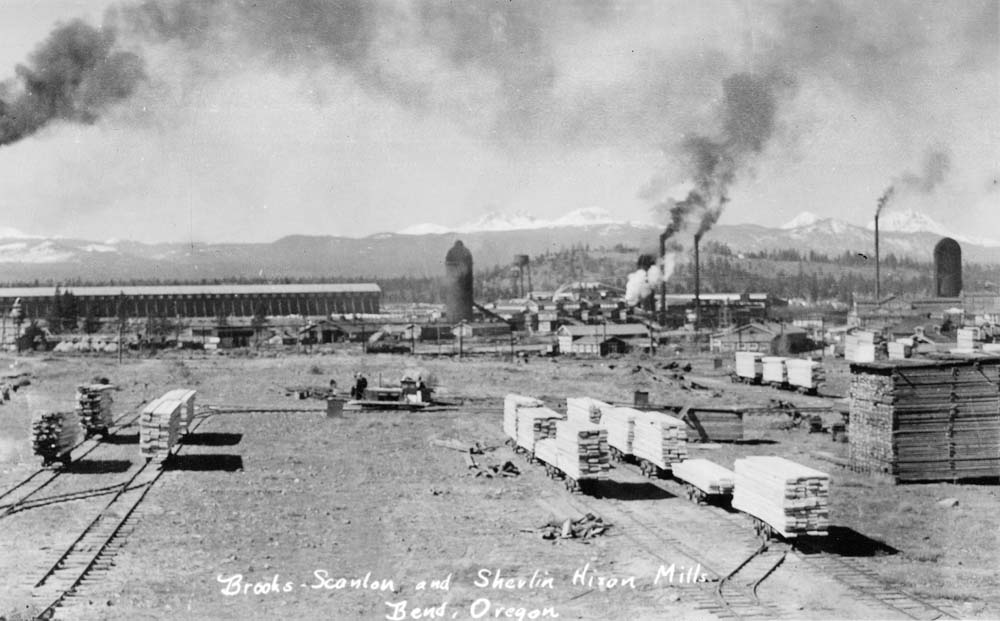
|
In addition to the logging railroad, Brooks-Scanlon also had a narrow gauge in plant switching railroad. Jeff Moore collection.
|
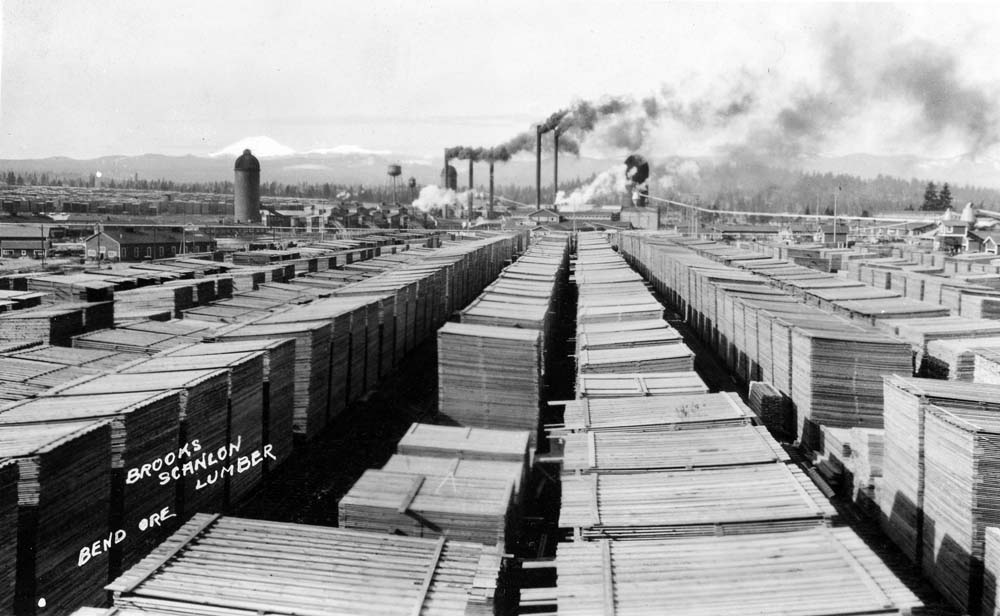
|
A vintage postcard view of the Brooks-Scanlon lumber yards. The lumber yards visible to the left background are Shevlin-Hixon's yards
across the river. Jeff Moore collection.
|
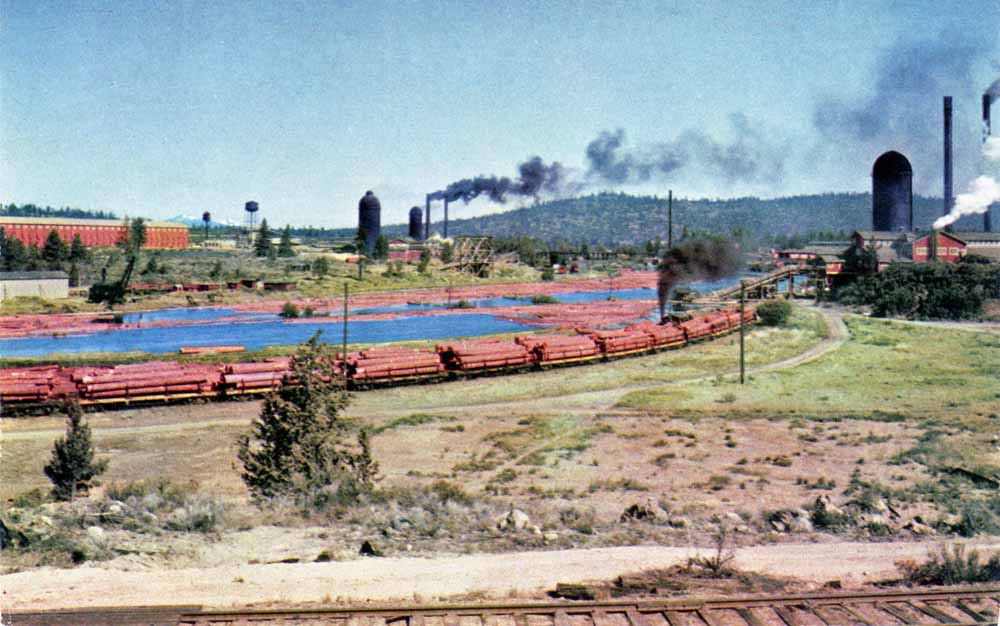
|
Sometime around 1950 the Union 76 company released a series of large postcards of roadside scenes around the west, two of which
featured the Brooks-Scanlon mill. In this view a steam locomotive can be seen running around a string of loaded log cars. Just visible to the right is
the Mill B complex, the smoke stacks visible in the background are at the Mill A complex. The other sawdust burner and some of the other buildings towards
the left are in the then closed Shevlin-Hixon mill across the river.
|
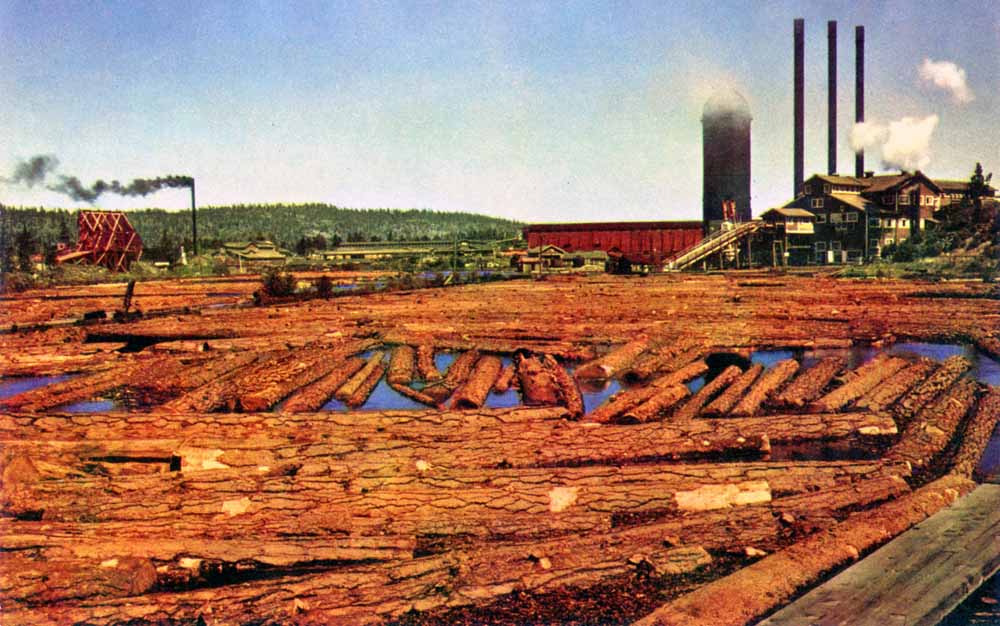
|
The other Union 76 postcard view of logs in the Deschutes River looking towards the Mill B complex, which is now
home to the Old Mill District shopping center.
|
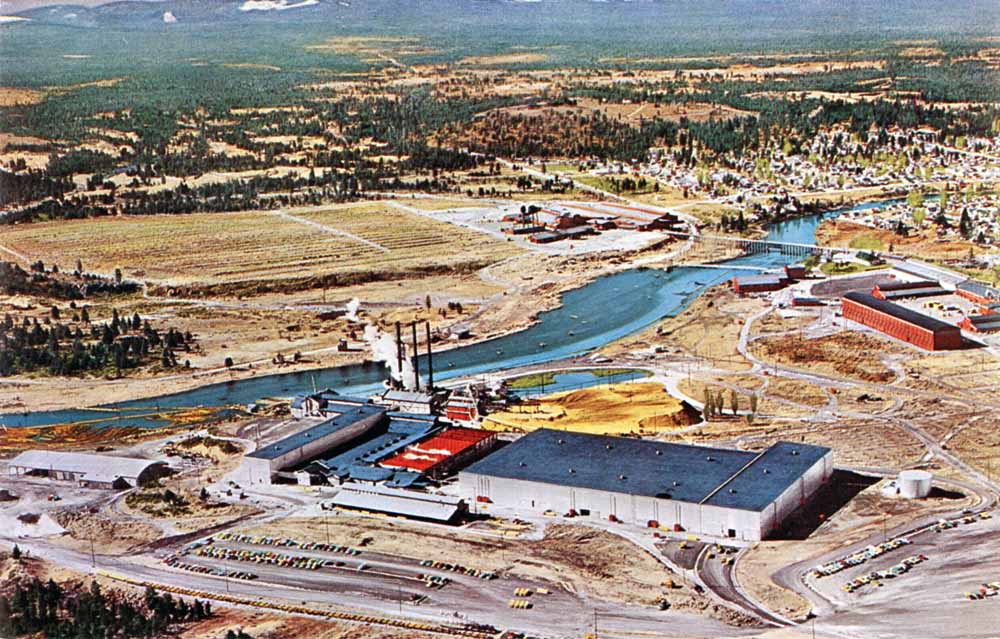
|
View of the Bend mill from a shipping postcard the company would mail to advise customers of shipment dates, car numbers, and other details sometime after the railroad closed. The
company had largely abandoned the original Mill A facilities and dramatically enlarged the Mill B complex. Visible across the river is the remnants of the Shevlin-Hixon mill complex. Jeff Moore collection.
|
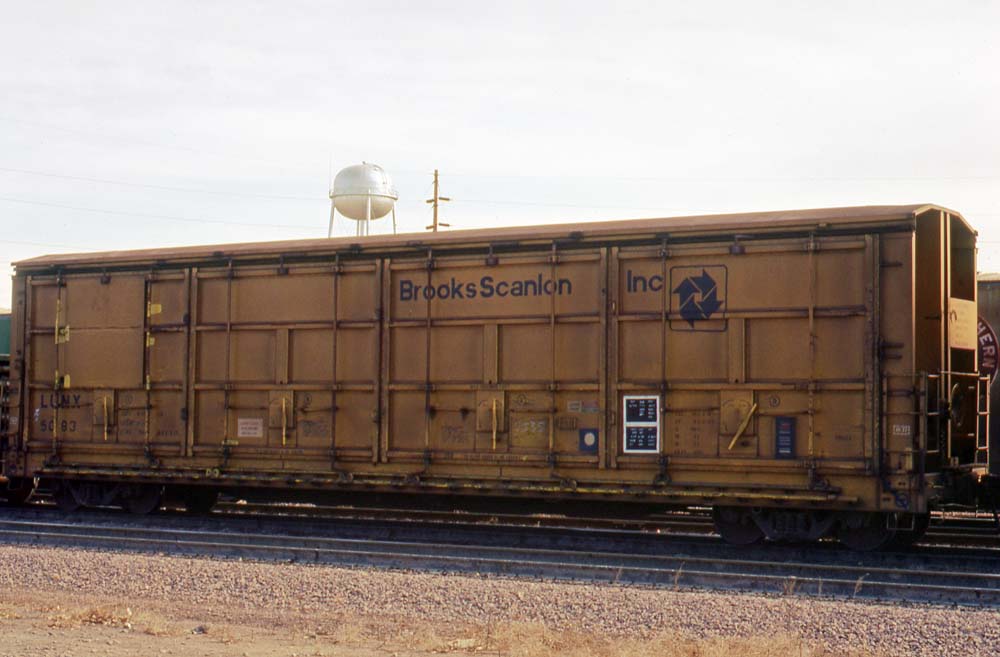
|
Quirks in the availability of railcars available for use in lumber and other forest product shipments in the late 1960s and early 1970s
restored the Brooks-Scanlon name to railroad equipment as the company leased a number of all-door boxcars and RBL-class refrigerator cars to handle shipments
from the Bend mill. Jeff Moore collection.
|
|
One of the
many remaining imprints that Brooks-Scanlon left in the Bend area...the sign for Brooks Camp road, near
Sisters. Jeff Moore photo.
|
|
Maps 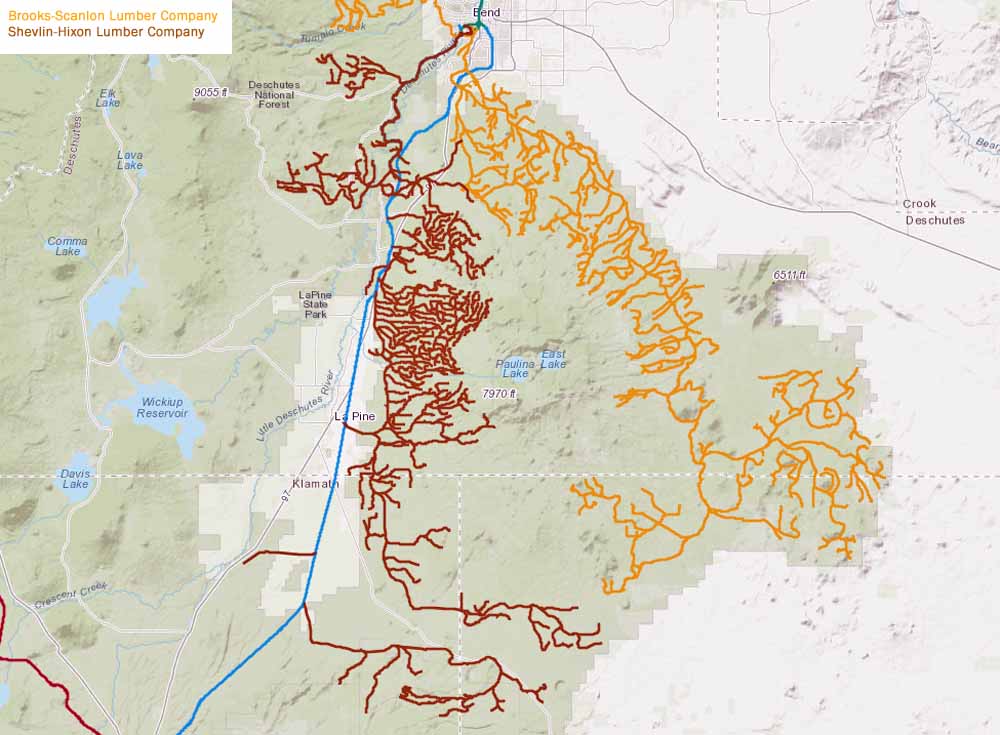
The logging railroad systems built south of Bend by Brooks-Scanlon and Shevlin-Hixon lumber companies. 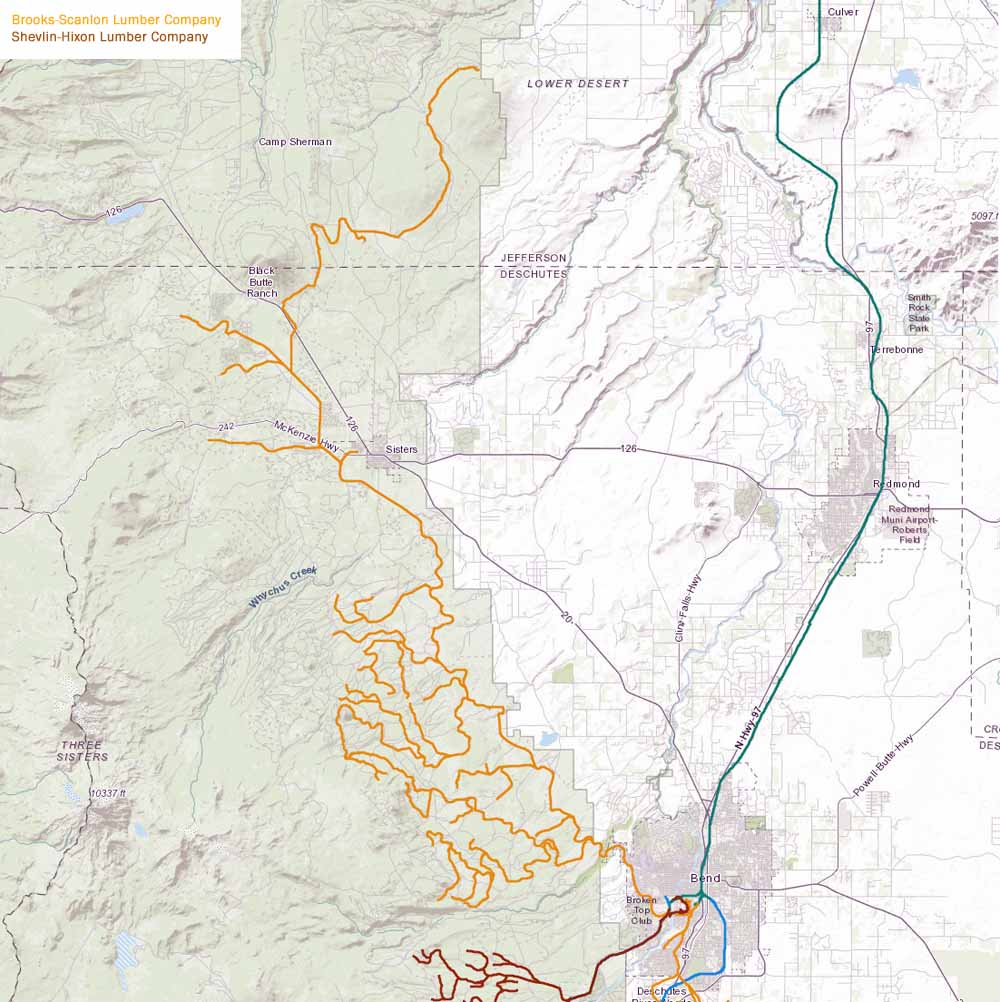
The Sisters Line and associated logging railroad system.
|
Locomotive roster Underlined numbers indicate a link to a page of pictures of that locomotive. #1- Baldwin 4-4-0, c/n 6972, built 1883. Built as Spokane & Inland Empire #4, to Spokane Portland & Seattle #56 1915, to Brooks-Scanlon Lumber Company 1915. Retired 1922, scrapped shortly afterwards. #2- Schenectady 2-6-0, c/n 2872, built 8/1889. Cylinders 18x24, Drivers 57", Boiler Pressure 155 lb., Tractive Effort 17,970 lb., Weight 108,100 lbs. Built as Oregon Railway & Navigation Company #92; to Union Pacific #1211; to Oregon Railway & Navigation Company #107; to Oregon-Washington Railway and Navigation #107; to Union Pacific #4204; to Bercules Sandstone in 1915; to Brooks Scanlon #2 2/1916. Sold to City of Prineville Railway as their #2 in 1925; Scrapped 1951. #3- Lima 3-truck Shay, c/n 2965, built 3/1918. Cylinders 12x15, Drivers 36", Boiler Pressure 200 lb., Tractive Effort 30,400 lbs, Weight 70 tons. Purchased new. Sold to Bend Iron Works for scrap 1953. #4- Baldwin 2-8-2, c/n 52726, built 12/1919. Cylinders 18x24, Drivers 44", Boiler Pressure 180 lb., Tractive Effort 27,000 lbs., Weight 145,000 lbs. Purchased new. Scrapped. #5- Baldwin 2-8-2, c/n 55399, built 5/1922. Cylinders 18x24, Drivers 44", Boiler Pressure 190 lb., Tractive Effort 28,600 lbs., Weight 144,000 lbs. Purchased new. To Georgia-Pacific Corporation #5. On display in Corvallis, OR. #6- Baldwin 2-8-2, c/n 56290, blt 3/1923. Cylinders 18x24, Drivers 44", Boiler Pressure 190 lb., Tractive Effort 28,600 lbs., Weight 144,000 lbs. Purchased new. Scrapped. 1st #7- Baldwin 2-8-2, c/n 58362, built 4/1925. Cylinders 18x24, Drivers 44", Boiler Pressure 190 lb., Tractive Effort 28,600 lbs., Weight 144,000 lbs. Purchased new; Renumbered Brooks-Scanlon #8. Sold to Valley & Siletz Railroad #56 1939. Scrapped. 2nd #7- Baldwin 2-8-2, c/n 56291, built 3/1923. Cylinders 18x24, Drivers 44", Boiler Pressure 180 lb., Tractive Effort 28,600 lbs., Weight 144,000 lbs. Built as Brooks-Scanlon-O'Brien #2, Stillwater, British Columbia; to Brooks-Scanlon 2nd #7. Scrapped. #8- Same machine as 1st #7 above. #101- Alco S-3 diesel electric switcher, c/n 79563, built 5/1952. 660 horsepower, 40" drivers, 6-cylinder model 539 engine, Weight 199,000 lbs. Purchased new. To Oregon & Northwestern #101 1956; to Longview Fibre #7001; to Battle Ground, Yacolt & Chelatchie Prairie Railroad Association. Currently in storage near Yacolt, WA. #102- Alco S-3 diesel electric switcher, c/n 79774, built 5/1952. 660 horsepower, 40" drivers, 6-cylinder model 539 engine, Weight 199,000 lbs. Purchased new. To Oregon & Northwestern #102 1956; to City of Prineville #103; to Kewash Railroad #103, Keota, iowa; to Dakota Southern Railroad. Scrapped December 2021/January 2022. #S-H 4- In addition to the above Brooks-Scanlon inherited six additional Baldwin 2-8-2s with the Shevlin-Hixon lumber company in 1950. The six were S-H #2, #4, #5, #6, #7, and #8. Only the #4 got Brooks-Scanlon lettering after the purchase, and B-S renumbered it S-H 4 to avoid any confusion with its own #4. All of the others remained in full Shevlin-Hixon markings until their retirement.
|
|
Photos of the Brooks-Scanlon Lumber Company Photos from the Chuck Johnson collection Equipment McGiffert Loaders Working with the Track Layer Log Flats at Collier State Park Surviving Camp Cars Old Mill District
|
|
References Books "Railroad Logging in the Klamath Country". Jack Bowden, Oso Publishing, 2004. "Green Gold: The incomplete, and probably inaccurate, history of the timber industry in parts of Central and Eastern Oregon from 1867 to near the present". Martin Gario Morisette, self published, 2005. Periodicals "Brooks-Scanlon, Inc." by Jack M. Holst, February 1970 Pacific RailNews: Pgs 4-17. "Brooks-Scanlon's Diesel McGifferts" by Martin Hansen, Winter 1986 Timberbeast: Pgs 18-23,27. "Closing the Lumberman's Frontier: The Far Western Pine Country" by Thomas R. Cox, July 1994 Journal of the West: Pgs 59-66. "Diesel Logging Locomotives" by John Taubeneck, Pete Replinger, Patrick Hind and John Henderson, August-October 1996 Tall Timber Short Lines: Pgs 10-31.
|
|
More on the Web Brooks Resources Home Page Old Mill District Home Page- Website of the Old Mill District, the commercial shopping center that currently occupies the Brooks-Scanlon sawmill complex.
|
|
|